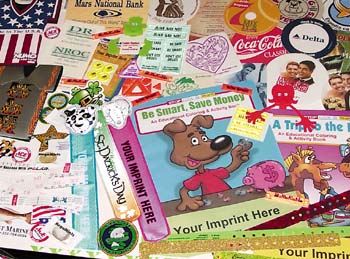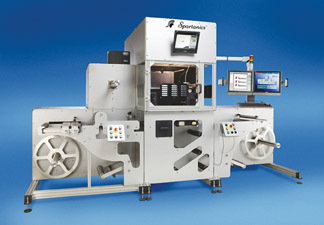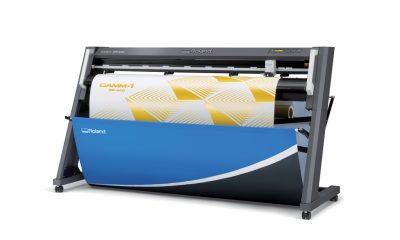Graphics Printing
Published
20 years agoon

One of the most important lessons business owners learned over the past few years is that in order to succeed, they must be open to change, new markets, and new technology. Most of the companies that did not adapt to the changing marketplace did not survive. Or, if they did survive, they certainly aren’t in the same financial shape they were in before the downturn.
Economic recessions create a great deal of hardship, but they also usher in a great many opportunities to diversify and improve a business. Innovation in products and increased productivity and efficiency are the hallmarks of companies that survive the tough times.
One of the most talked about diversification strategies in screen printing over the past few years has been adding digital technologies to production. Most screen printers have figured out the benefits of using digital printers to produce short-run, high-quality imaging at a reasonable price. But, as the digital-imaging field begins to see a higher level of competition, it may be a good idea to find other markets to capitalize on, given your established screen-printing expertise and equipment.
If you want to enter a new market with a minimal investment, the advertising-specialty industry may be the best place to focus. All it takes to add specialty promotional products is your current printing equipment, plus some simple tooling, a few jigs, and a basic understanding about how the ad-specialty industry is structured. On the following pages, you’ll find out how you can break into this lucrative market.
Don’t get the impression that there is no cost associated with a move into ad specialties. You’ll spend money on marketing, research, sales, and staff training, the amount of which will vary depending upon your product’s level of complexity, your production and sales volume goals, and how fast you want to hit the market. But overall, you can get an ad-specialty line off the ground much more economically than starting a new business from scratch.
What are ad specialties?
Ad specialties, or promotional products, are any products that can be personalized, labeled, or otherwise marked to serve as a promotional item for a company, organization, group, or individual (Figure 1). They range from items such as matchbooks at the low end to expensive jewelry on the high end. Most people think of things such as pens, pencils, and T-shirts when talking about ad specialties. The market includes much more than that, and it’s growing all the time.
The most encouraging aspect of all of this promotional demand is that just about anything can be used as a promotional item, and any screen-printing specialist, whether it’s graphics, garments, or even electronics, can get into the game. In essence, anything that can be used for promotional purposes can be considered an ad specialty. Even such things as auto-dealer license-plate frames are promotional items. And every year, hundreds of new products are added to the list of available promotional products.
It is actually quite amazing to see the products that get used for promotional purposes. It seems like as soon as a new product is introduced to the consumer market, someone figures out a way to use it as a promotional product. For example, the stainless-steel, insulated, travel coffee mugs became available as ad specialties within a year of their introduction.
Organizations and affiliations
The promotional industry is a well-organized machine. The key trade groups that make it work so well are the Advertising Specialty Institute (ASI) and the Promotional Products Association International (PPAI). ASI is the best known of these groups, but the PPAI has increased its strength and boosted its reputation in recent years. Both make various levels and types of membership available depending upon your involvement in the industry. The main types of membership are distributor and supplier. Distributors sell promotional items to companies and organizations. Suppliers offer promotional items to the distributors to sell.
There is another type of ad-specialty distributor–the distributor who also manufacturers promotional products. This scenario is actually quite common among screen printers, as they have a ready supply of customers for their regular products who also need advertising specialties. Most of these companies join the trade organizations as distributors so that they can still buy other items to complement those that they make themselves.
The method of communication between distributors and suppliers also makes this industry work as well as it does. Sales materials do not identify the supplier by name. The catalogs or brochures that the distributors use to show their customers a particular item only identify the supplier by a number. This secrecy helps keep the customer from contacting the supplier directly. While some may think this system is heavy handed or restrictive, its real goal is to maintain a positive relationship between the suppliers and distributors. After all, what incentive does a distributor have to promote a supplier’s products if they are worried that the customer could just go direct?
The industry organizations provide a great service to both suppliers and distributors. They simplify the marketing and coordinate communications. Once a supplier has made its product known to distributors, the distributors technically become the supplier’s sales force. Two small companies with which I am familiar–both make various types of bags such as totes, backpacks, briefcases, and luggage–receive more than 40 or-ders a week each. These are companies with fewer than ten employees, but their sales forces number in the thousands.
Supplier membership in one or both of these organizations allows you access to the distributors in that network, and it gives you the opportunity to participate in their trade shows and display your products in their catalogs. None of this participation is free, but compared to the cost of marketing your products yourself directly to the end customers, the cost per contact is remarkably low.
There is a catch-22 to joining these organizations: In most cases, they want proof that you are already dealing with ad-specialty distributors before you can gain full membership. In some cases, however, you can obtain provisional membership without many previous sales into the industry. But these memberships usually come with limited access to data and marketing tools. So you need to join to do the marketing, but you need to have proof that you have sold products to join. It is not an impossible situation, but it does offer the organizations a way to make sure that only companies that are serious about the industry get in.
In terms of product, I recommend that you start with something basic that is already available, is easy for your company to make, and is in constant demand. For instance, a screen printer who produces magnetic signs can easily make refrigerator magnets that can be sold as ad specialties. Garment printers can do the same with T-shirts and other apparel. Then, by promoting the products to just the local distributors, the printer can quickly get a few orders to open up membership in the trade organizations.
Once you join an organization, you need to work on unique items that will set you apart from the other suppliers. In some cases, you may be able to produce the same items as other suppliers, but with a quicker turnaround time. In any event, you shouldn’t have to make a huge investment to put your equipment to work making items for the ad-specialty industry.
Marketing
The marketing strategies for promotional products are as diverse as the products themselves. But the most critical components of any promotional-product marketing campaign are the industry trade shows and the master catalogs that the trade organizations produce. The trade shows are essential venues for new players in the market, as well as any suppliers introducing new items. The promotional-products industry is probably one of the most enthusiastic when it comes to trade-show attendance. The distributors look forward each year to attending the shows to get information about new items. As I mentioned earlier, new items drive this whole industry. While good-quality standards will always sell well, new items keep the overall interest up.
Most distributors make sure that their sales staffs attend at least one industry show each year. Many of the top distributors use attendance at national trade shows as a perk for their top performers. Others make sure that the top salespeople go to the national shows and others attend the regional and local events.
For a new company, it is most important that you participate in at least one national organization’s big annual trade show. These events get the most play and will give a supplier the quickest jump into the market. One of the tote-bag companies that I mentioned earlier in this article was absent from the national shows for several years, and when it started doing the shows again, its business volume doubled almost immediately.Mike Ukena
Part of participating in the national shows involves being ready with a load of samples. Anyone who has ever visited the office/showroom of an advertising-specialty distributor can attest to the plethora of samples on display. It’s almost like walking into a gift shop. Any company interested in becoming a player in the promotional market must factor in a high volume of samples to hand out at shows and/or send by direct mail to distributors.
The master catalogs that the trade organizations produce are the second key marketing tool. These industry bibles are widely used, and a supplier’s presence in the books adds a significant amount of credibility to its efforts. It is not an inexpensive effort, but it is important to be present in these books. The companies that are in the books can attest to the value. Unfortunately, the marketing data that would prove these statements is closely guarded by the trade organizations–and they only share the information with their members. However, numerous supplier members have told me that their participation in the catalogs did give them a significant boost in orders, especially from the smaller distrib-utors that were not able to see their merchandise at the trade shows.
The third most important marketing tool is the supplier catalog (Figure 2). This catalog can be as simple as a small, direct-mail slick to a larger, multipage piece. A new company that has just a few items to market can get by with a small, two- to four-page brochure that doubles as a direct-mail flyer. These flyers are not treated as junk mail, as is the case with the general public. They’re opened and examined carefully by distributors–always looking for a new item to present to their clients.
Along with the catalog brochure, the suppliers that market small and inexpensive items will often times send samples by direct mail to ad-specialty distributors. The trade organizations provide mailing lists that you can tailor to fit the needs of any size or type of supplier. You can obtain lists that target distributors by sales volume, area of interest, or location.
Last but not least, larger suppliers use dedicated sales representatives to present their products to distributors. I mention this type of marketing last, not because it is the least important, but because of its higher expense. Most suppliers have found that to get started in this industry, they can concentrate their marketing budgets on the previously mentioned avenues.
Pricing
The advertising-specialty industry uses a coded pricing system to allow the distributors to know in a glance what their cost and margin is on every product that they sell. All sales materials provided by the suppliers have a letter or number code for each pricing level that indicates the discount for that price. All sales literature shows the retail or final price to the end customer. The simple code system quickly shows the sales representative how much room they have to negotiate discounts.
One of the underlying keys to this pricing and discount technique is to come up with a pricing structure that gives the distributor’s sales representative a stronger incentive to sell your product instead of another. Psychologically, it is best to offer the deepest discount schedule. The tradeoff is that to do so, you have to establish a higher suggested retail price. The only way to be sure whether what you have is acceptable is to research the pricing structure of competitors that are supplying the same or similar products.
Obviously, the best competitive situation is to come up with a product that has no competitors. Such scenarios are seldom permanent, but it is always better to be the trendsetter than the follower. Being the company that sets the initial pricing for a given product category is far preferable to being one of the competitors that tries to sell the same product.
Coming up with product ideas
It seems that almost any product can be personalized in some way to make it into a promotional tool. Based on that, you might think that coming up with new items should be easy. If you have something very unique and different, it might be easy. But remember that there are a lot of companies out there trying to come up with the next super item.
One important key to coming up with ideas for products is market research. A successful supplier I know came up with some basic items to make it possible to join the ASI and then attended every industry trade show he could to see what was out there. His efforts paid off with a new bag design that was unique enough to attract a lot of business. And, although other companies quickly copied his idea, he had a year-long head start before anyone else could get their version into the master catalog, and thus he became widely known as the principal source for the type of bag.
A valuable asset to market research is to develop a relationship with ad-specialty distributors and brainstorm ideas with them. The supplier I just mentioned did exactly that. He met periodically with the owner of a local, medium-sized distribution business, and they shared ideas and concepts. The meeting became an excellent source of ideas for his product line.
Do not despair if you are totally lost when it comes to ideas. One of the quickest ways to get charged up about developing products is to just look at what is already out there. Visit a local ad-specialty distributor and tell them what you are trying to do. Most, if not all, will be more than happy to help because they’re always looking for new items. They’ll probably see you as a potential client–at least initially.
Another point to remember is that once you come up with a good item, the market longevity of it may be many years. Unlike the consumer market, which has a very short attention span, the ad-specialty market does not cast aside good items quickly. A product may garner large orders from major companies early in its lifecycle, but it can move on to smaller and smaller companies as time goes by and still generate excellent returns.
But wait, there’s more
One of the key advantages to the promotional-products industry is that it can generate a consistent business flow. Yes, there are seasonal variations for some types of items, but most companies view ad specialties as a great, inexpensive (or less expensive) form of advertising. Therefore, even when companies are experiencing their own business recessions, promotional items are one of the last things that they cut from their budgets.
Obviously, the lower the price point of an item, the larger the potential volume. But that does not rule out more expensive products as possible promotional items. Whichever way you choose to go–supplier, distributor, or a distributor who also manufactures–advertising specialties are worth a look.

Subscribe

Magazine
Get the most important news
and business ideas from Screenprinting Magazine.
Most Popular
-

 Case Studies2 months ago
Case Studies2 months agoHigh-Density Inks Help Specialty Printing Take Center Stage
-

 Art, Ad, or Alchemy2 months ago
Art, Ad, or Alchemy2 months agoF&I Printing Is Everywhere!
-

 Andy MacDougall2 months ago
Andy MacDougall2 months agoFunctional and Industrial Printing is EVERYWHERE!
-

 Columns3 weeks ago
Columns3 weeks ago8 Marketing Mistakes Not to Make When Promoting Your Screen Printing Services Online
-

 Editor's Note3 weeks ago
Editor's Note3 weeks agoLivin’ the High Life
-

 Marshall Atkinson3 weeks ago
Marshall Atkinson3 weeks agoHow to Create a Winning Culture in Your Screen-Printing Business
-

 Thomas Trimingham2 months ago
Thomas Trimingham2 months ago“Magic” Marketing for Screen Printing Shops
-

 News & Trends2 months ago
News & Trends2 months agoWhat Are ZALPHAS and How Can You Serve Them in Your Print Business?






